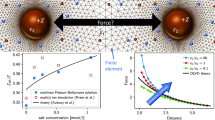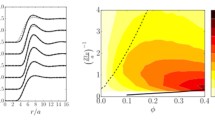Abstract
The pair correlation function of charge stabilized colloidal particles under strongly sheared conditions is studied using the analytical intermediate asymptotics method recently developed in Banetta and Zaccone (Phys. Rev. E 99, 052606 (2019) to solve the steady-state Smoluchowski equation for medium to high values of the Péclet number; the analytical theory works for dilute conditions. A rich physical behaviour is unveiled for the pair correlation function of colloids interacting via the repulsive Yukawa (or Debye-Hückel) potential, in both the extensional and compressional sectors of the solid angle. In the compression sector, a peak near contact is due to the advecting action of the flow and decreases upon increasing the coupling strength parameter Γ of the Yukawa potential. Upon increasing the screening (Debye) length κ− 1, a secondary peak shows up, at a larger separation distance, slightly less than the Debye length. While this secondary peak grows, the primary peak near contact decreases. The secondary peak is attributed to the competition between the advecting (attractive-like) action of the flow in the compressions sector, and the repulsion due to the electrostatics. In the extensional sectors, a depletion layer (where the pair-correlation function is identically zero) near contact is predicted, the width of which increases upon increasing either Γ or κ− 1.





Similar content being viewed by others
Change history
28 May 2020
The author noticed that the published paper contained error. Unfortunately, the published version does not have the author’s approval since there are problems with equations that are completely unreadable.
References
Larsen J (2017) Foundations of high-energy-density physics: Physical processes of matter at extreme conditions. Cambridge University Press, Cambridge
Hansen JP (1973) Statistical mechanics of dense ionized matter. I. Equilibrium properties of the classical one-component plasma. Phys Rev A 8:3096–3109
Dhont JKG (1996) An introduction to dynamics of colloids. Elsevier Science, New York
Fortov VE, Petrov OE, Vaulina OS, Koss KG (2020) Brownian motion of dust particles in a weakly ionized plasma. JETP Lett 97:322–326
Preziosi V, Perazzo A, Tomaiuolo G, Pipich V, Danino D, Paduano L, Guido S (2017) Flow-induced nanostructuring of gelled emulsions. Soft Matter 13:5696
Löwen H, Hansen JP, Roux JN (1991) Brownian dynamics and kinetic glass transition in colloidal suspoensions. Phys Rev A 44:1169–1181
Falkovich G, Fouxon A, Stepanov MG (2002) Acceleration of rain initiation by cloud turbulence. Nature 419:151–154
Batchelor GK, Green JT (1972) The determination of the bulk stress in a suspension of spherical particles to order c2. J Fluid Mech 56:401–427
Batchelor GK, Green JT (1972) The hydrodynamic interaction of two small freely-moving spheres in a linear flow field. J Fluid Mech 56:375–400
Blawzdziewicz J, Szamel G (1993) Structure and rheology of semidilute suspension in shear flow. Phys Rev E 48:4632
Brady JF, Morris JF (1997) Microstructure of strongly sheared suspensions and its impact on rheology and diffusion. J Fluid Mech 348:103–139
Brady JF, Bossis G (1988) Stokesian dynamics. Ann Rev Fluid Mech 74:111–157
Morris JF, Katyal B (2002) Microstructure from simulated Brownian suspension flows at large shear rate. Phys Fluids 14:1920–1937
Nazockdast E, Morris JF (2012) Microstructural theory and the rheology of concentrated colloidal suspensions. J Fluid Mech 713:420–452
Nazockdast E, Morris JF (2012) Effect of repulsive interactions on structure and rheology of sheared colloidal dispersions. Soft Matter 8:4223–4234
Banetta L, Zaccone A (2019) Radial Distribution Function of Lennard Jones Fluids in shear flows from intermediate asymptotics. Phys Rev E 99:052606
Brenner H (1961) The slow motion of a sphere through a viscous fluid towards a plane surface. Chem Eng Sci 6:242–251
Honig EP, Roebersen GJ, Wieresema PH (1971) Effect of hydrodynamic interaction on the coagulation rate of hydrophobic colloids. J. Coll. Interface Sci. 36:97
Adler PM (1981) Interaction of unequal spheres. I. Hydrodynamic interaction: colloidal forces. J Colloidal Int Sci 84:461–473
Lin CJ, Lee KJ, Sather NF (1970) Slow motion of two spheres in a shear field. J Fluid Mech 43:35–57
Bender CM, Orszag SA (1999) Advanced mathematical methods for scientists and engineers I: Asymptotic methods and perturbation theory. Springer Science & Business Media, New York
HinchJ (1991) Perturbation methods. Cambridge University Press, Cambridge
Van Dyke M (1975) Perturbation methods in fluid mechanics, (Parabolic Press Stanford
Zaccone A, Wu H, Gentili D, Morbidelli M (2009) Theory of activated process under shear with application to shear-induced aggregation of colloids. Phys Rev E 80:051404
Batchelor GK (1976) Brownian diffusion of particles with hydrodynamic interaction. J Fluid Mech 74:1–29
Ness C, Zaccone A (2017) Effect of hydrodynamic interactions on the lifetime of colloidal bonds. Ind Eng Chem Res 56:3726–3732
Nosenko V, Ivlev AV, Morfill GE (2012) Microstructure of a liquid two-dimensional dusty plasma under shear. Phys Rev Lett 108:135005
Ott T, Bonitz M, Stanton LG, Murillo MS (2014) Coupling strength in Coulomb and Yukawa one-component plasmas. Phys Plasmas 21:113704
Fuchs M, Ballauff M (2005) Flow curves of dense colloidal suspensions: Schematic model analysis of the shear-dependent viscosity near the colloidal glass transition. J Chem Phys 122:094707
Banchio AJ, Bergenholtz J, N’agele G (1999) Viscoelasticity and generalized Stokes-Einstein relations of colloidal dispersions. J Chem Phys 111:8721–8740
Ballauff M, Brader JM, Egelhaaf SU, Fuchs M, Horbach J, Koumakis N, Krüger M, Laurati M, Mutch KJ, Petekidis G, Siebenbürger M, Voigtmann TH, Zausch J (2013) Residual stresses in glasses. Phys Rev Lett 110:215701
Siebenbürger M, Ballauff M, Voigtmann TH (2012) Creep in colloidal glasses. Phys Rev Lett 108:255701
Amann CHP, Denisov D, Dang MT, Struth B, Schall P, Fuchs M (2015) Shear-induced breaking of cages in colloidal glasses: Scattering experiments and mode coupling theory. J Chem Phys 143:034505
Toneian D, Likos CN, Kahl G (2019) Controlled self-aggregation of polymer-based nanoparticles employing shear flow and magnetic fields, vol 3
Melis S, Verduyn M, Storti G, Morbidelli M, Baldyga J (1999) Effect of fluid motion on the aggregation of small particles subject to interaction forces. AlChe J 45:1383–1393
Acknowledgments
This work is dedicated to Prof. Matthias Ballauff in occasion of his retirement. Prof. Massimo Morbidelli is gratefully acknowledged for many inspiring discussions and for providing motivation to study this problem. L.B. gratefully acknowledges financial support from Synthomer UK Ltd.
Author information
Authors and Affiliations
Corresponding author
Additional information
Publisher’s note
Springer Nature remains neutral with regard to jurisdictional claims in published maps and institutional affiliations.
The original version of this article was revised: The author noticed that the published paper contained error. Unfortunately, the published version does not have the author’s approval since there are problems with equations that are completely unreadable.
Appendices
Appendix A: Mathematical formalism
Let’s focus or attention on the Brownian contribution to Eq. 16:
Expressing all the components and the divergence operator we obtain, respectively
and
If we neglect the lubrication forces acting on tangential directions we end up with
Since every contribution from the angular coordinates disappeared it is possible to apply the angular average directly on the pcf on this portion of Eq. 17.
Appendix B: Angular averaging
In this section we describe the procedure where we describe the angular averaging procedure with which we evaluate \(\langle \tilde {\textbf {v}} \rangle \) and \(\langle \tilde {\nabla } \cdot \tilde {\textbf {v}} \rangle \). We start the procedure from Eq. 40
where \(A(\tilde {r})\) and \(B(\tilde {r})\) are functions representing the effect of the hydrodynamic disturbance along the radial and angular coordinate, respectively. Their values can be taken from the literature [8] and, in order to use them in the present analytical calculations, they are fitted through the following algebraic expressions [35]:
Our goal is to evaluate the average radial velocity in the area where the particles are approaching each other, which means the ensemble of angular coordinates \(\tilde {v}_{r} < 0 \).
It is found that the above mentioned condition is satisfied, for \(\tilde {r} >0\), ∀𝜃 ∈ [0,π], ϕ ∈ [π/2,π] and ϕ ∈ [3π/2, 2π]. Now we apply the angular average obtaining:
Through this procedure we can obtain
To find the upstream region we need to impose \(\tilde {v}_{r}>0\), which is given by ∀𝜃 ∈ [0,π], ϕ ∈ [0,π/2] and ϕ ∈ [π, 3π/2]. Applying the same procedure seen before for αc we obtain:
and, as a consequence
From this point onward we will consider the compressional case only; the extensional one can be derived in a straightforward manner by replacing αc with αe.
Next we consider the divergence of the flow field, which can be written in spherical coordinates as
Adopting the correlations in Eq. 40, we can evaluate the divergence as
Finally, we apply the integral average previously seen for 〈v〉i and we obtain:
with i = c,e for compression (c) and extension (e), respectively.
Rights and permissions
About this article
Cite this article
Banetta, L., Zaccone, A. Pair correlation function of charge-stabilized colloidal systems under sheared conditions. Colloid Polym Sci 298, 761–771 (2020). https://doi.org/10.1007/s00396-020-04609-4
Received:
Revised:
Accepted:
Published:
Issue Date:
DOI: https://doi.org/10.1007/s00396-020-04609-4




